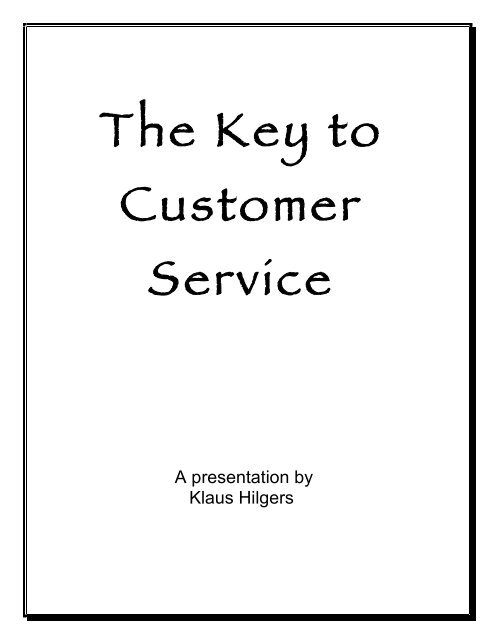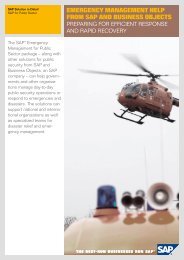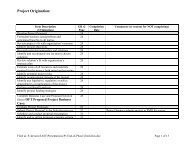The Key to Customer Service
The Key to Customer Service
The Key to Customer Service
Create successful ePaper yourself
Turn your PDF publications into a flip-book with our unique Google optimized e-Paper software.
<strong>The</strong> <strong>Key</strong> <strong>to</strong><br />
Cus<strong>to</strong>mer<br />
<strong>Service</strong><br />
A presentation by<br />
Klaus Hilgers
© 2005 Epoch Consultants, Inc. All Rights Reserved.<br />
Epoch Consultants, Inc.<br />
1156 NE Cleveland Street<br />
Clearwater, Florida 33755<br />
727-447-1773 phone<br />
727-449-0931 fax<br />
epochconsultants@verizon.net<br />
www.epoch-consult.com
PURPOSE:<br />
Purpose<br />
To empower the participants <strong>to</strong> provide courteous, quick and friendly<br />
service <strong>to</strong> their cus<strong>to</strong>mers <strong>to</strong> help generate new and repeat business.<br />
Intended Results:<br />
1. Each employee is committed <strong>to</strong> providing excellent service.<br />
2. Each employee knows the cycle of cus<strong>to</strong>mer service.<br />
3. Employees recognize that each interaction with the cus<strong>to</strong>mer is a "moment<br />
of magic."<br />
4. Employees know how <strong>to</strong> identify and avoid she mistakes of poor<br />
service.<br />
5. Employees know how <strong>to</strong> effectively handle cus<strong>to</strong>mer<br />
problems and/or complaints.<br />
6. Employees understand the relationship between <strong>Service</strong>, New<br />
Business and Repeat Business.<br />
7. <strong>The</strong> company is well-known and well-thought of in the community.
Cus<strong>to</strong>mer <strong>Service</strong> Management<br />
Cus<strong>to</strong>mer <strong>Service</strong> Management is a business<br />
strategy that includes acquiring, s<strong>to</strong>ring,<br />
evaluating and distributing knowledge about<br />
the cus<strong>to</strong>mer <strong>to</strong> the various contact points m<br />
our organization in order <strong>to</strong>:<br />
COMMUNICATE<br />
UNDERSTAND<br />
ANTICIPATE<br />
& MANAGE<br />
THEIR NEEDS<br />
so that we exceed our cus<strong>to</strong>mer's expectations.
Definition of Cus<strong>to</strong>mer<br />
1. A cus<strong>to</strong>mer is someone with whom you exchange<br />
something.<br />
2. A cus<strong>to</strong>mer is someone who has not found a better<br />
alternative.
MEASURING CUSTOMER<br />
SATISFACTION<br />
1. Who are my cus<strong>to</strong>mers?<br />
2. What do they want and need?<br />
3. What is our product or service?<br />
4. Is there agreement between the parties as <strong>to</strong> what the product or<br />
service is and the conditions of satisfaction?<br />
5. Does our product or service meet their expectations and/or<br />
standards?<br />
6. How do they and we measure our success?<br />
7. Does our product or service exceed their expectations?<br />
8. Are we efficiently organized <strong>to</strong> produce that product or service? What's<br />
our process? What technologies are we using and need? Is our staff<br />
trained in our process and technology so that the product or service is<br />
produced?<br />
9. Is there an effective communication system in place and operational<br />
between our cus<strong>to</strong>mers and us?<br />
10.1s there an effective tracking system that provides information on our<br />
operations and our cus<strong>to</strong>mers?<br />
11.Do we have a Quality Assurance Program that inspects, corrects and<br />
validates our policies, procedures and people?<br />
12. Are our cus<strong>to</strong>mers happy and acknowledging and promoting our<br />
products and services? Are we well known and well thought of?
Your Cus<strong>to</strong>mers<br />
Take a few moments <strong>to</strong> identify the various cus<strong>to</strong>mers of/in your organization.<br />
External Cus<strong>to</strong>mers:<br />
1._____________________________________________________________<br />
2.__________________________________________________________________<br />
3.________________________________________________________________<br />
4.___________________________________________________________________<br />
5. _________________________________________________________________________<br />
Internal Cus<strong>to</strong>mers:<br />
1._____________________________________________________________<br />
2.___________________________________________________________________<br />
3._________________________________________________________________<br />
4.____________________________________________________________________<br />
5. __________________________________________________________________
Cus<strong>to</strong>mer Survey:<br />
Property Tax Division<br />
Texas Comptroller of Public Accounts<br />
This survey is designed <strong>to</strong> help the Comptroller meet your needs. Your responses will help<br />
us determine:<br />
• what services we should provide,<br />
• what services we should not provide and<br />
• what services we should improve,<br />
You may sign your name or respond anonymously. <strong>The</strong> survey results will be published in<br />
the March issue of STATEMENT.<br />
Please check your place of employment:<br />
County appraisal district<br />
Tax office<br />
School district<br />
Private law firm<br />
Taxpayer<br />
Private appraisal firm<br />
other<br />
Overall Perception of the Property Tax Division<br />
1. Does the division meet your needs as a cus<strong>to</strong>mer?<br />
Yes<br />
Frequently<br />
Sometimes<br />
No<br />
2. Does the division work well with the appraisal districts?<br />
Yes<br />
Frequently<br />
Sometimes<br />
No
3. If no, how could we improve our services?<br />
4. If you could change or improve anything in our process, what would it be?<br />
5. What would you consider <strong>to</strong> be superior service from our division?<br />
6. Based upon your past experience with the division, how would you describe the<br />
overall attitude of the staff?<br />
Operations<br />
7. Do you use the results of the Annual Property Value Study for any purpose other<br />
than as a fac<strong>to</strong>r in the school funding formula? (For example, do you use the study <strong>to</strong><br />
gauge property values for planning purposes?)<br />
Yes<br />
No<br />
If yes, please explain:<br />
____________________________________________________________________<br />
____________________________________________________________________<br />
____________________________________________________________________<br />
8. Is the Annual Property Value Study easy <strong>to</strong> read and understand?
Very easy<br />
Somewhat easy<br />
Somewhat difficult<br />
Very difficult<br />
9. If you find it difficult, please explain your suggested changes.<br />
____________________________________________________________________<br />
____________________________________________________________________<br />
____________________________________________________________________<br />
10. Do you like the format?<br />
Yes<br />
No<br />
11. If no, please explain below how you would change the format.<br />
____________________________________________________________________<br />
____________________________________________________________________<br />
____________________________________________________________________<br />
12. Should we offer the study on diskettes as an alternative <strong>to</strong> mailing out paper<br />
reports?<br />
Yes<br />
No<br />
13. Should the division include statistical measurements in addition <strong>to</strong> the Median<br />
Appraisal Ration, Coefficient of Dispersion and Price-Related Differential?<br />
Yes<br />
No
Excerpts from Cus<strong>to</strong>mer Survey: Property Tax Division
1.<br />
2.<br />
3.<br />
4.<br />
Four Types of Exchange
EXERCISE: Knowing Your Product!<br />
1. Write down what your real product or service is. Look at it from the cus<strong>to</strong>mer’s<br />
viewpoint.<br />
2. Write down five features of your product or service.<br />
3. Turn each feature in<strong>to</strong> a benefit.<br />
4. Meet with your cus<strong>to</strong>mer and ask them if they agree with your product<br />
statement and the benefits you feel they receive from your service. If they<br />
disagree, find out what they think it is.<br />
5. Ask your cus<strong>to</strong>mer how they would measure your success. What are<br />
their conditions of satisfaction?
SERVICE:<br />
• Help;<br />
• Use;<br />
• Benefit;<br />
• Advantage;<br />
Definitions<br />
• Conduct tending <strong>to</strong> or contributing <strong>to</strong> the welfare or advantage of<br />
others;<br />
• <strong>The</strong> act of furnishing or supplying with something needed or wanted;<br />
• Assistance.<br />
ASSIST:<br />
• verb: To give help or aid.<br />
• noun: <strong>The</strong> act of a player who passes a ball or puck in such a way<br />
that a teammate can score a goal.
<strong>The</strong> Assist Drill<br />
1. Write 2 examples of a failed assist.<br />
2. Write 2 examples of a successful assist.<br />
3. What is the difference between 1 and 2?
Creating Cus<strong>to</strong>mer Loyalty<br />
GREETING<br />
Warm and professional<br />
Begin with “Open Question”<br />
State your delight <strong>to</strong> help
Determine Needs<br />
Find out what is wanted and needed<br />
Take notes, use names<br />
Get agreement between parties on what’s<br />
wanted and needed
Respond<br />
Give clear, relevant information, answer<br />
question and acknowledge statements<br />
Check for cus<strong>to</strong>mer understanding<br />
Confirm order, summarize
Exchange in Abundance<br />
Provide additional information<br />
Provide additional suggestions<br />
Provide abundant service
Closing<br />
Review agreements<br />
Thank the cus<strong>to</strong>mer<br />
Follow – up<br />
Stay in <strong>to</strong>uch for the future
HOW TO BE<br />
"CUSTOMER CENTERED!”<br />
<strong>The</strong> Marketing Science Institute of Cambridge, Massachusetts asked<br />
CUSTOMERS of a wide range of service businesses what fac<strong>to</strong>rs<br />
they considered most important in assuring their satisfaction. This is<br />
the response:<br />
1. RELIABILITY: This <strong>to</strong>pped the list of what cus<strong>to</strong>mers expect. A major<br />
source of cus<strong>to</strong>mer dissatisfaction is the "unkept promise."<br />
2. RESPONSIVENESS: Be helpful and provide prompt service.<br />
3. ASSURANCE: Employees should be knowledgeable and courteous<br />
and should convey confidence in the service they provide.<br />
4. EMPATHY: Cus<strong>to</strong>mers want individualized attention and people who<br />
will listen <strong>to</strong> them.<br />
5. TANGIBLES: Physical facilities and equipment should be attractive<br />
and clean. Employees should be dressed and groomed well.
Drill: Cus<strong>to</strong>mer Centered<br />
Write down 1 example of how you can improve these points.<br />
1.<br />
2.<br />
3.<br />
4.<br />
5.
Cus<strong>to</strong>mer Communications<br />
<strong>The</strong> Six Most Common Complaints<br />
1. Over-promising / Under-delivering.<br />
2. Failing <strong>to</strong> stay in <strong>to</strong>uch.<br />
3. Using <strong>to</strong>o much industry/inside jargon.<br />
4. Failing <strong>to</strong> listen <strong>to</strong> cus<strong>to</strong>mers' concerns/ideas.<br />
5. Telling rather than explaining.<br />
6. Communicating without courtesy<br />
— Source: Gallup Survey
Chapter 12<br />
Statements <strong>to</strong> Avoid<br />
TELEPHONE TECHNIQUES:<br />
SOME STATEMENTS TO AVOID<br />
Sometimes we make statements on the phone and<br />
we don't realize how the caller may interpret them.<br />
"He is not in <strong>to</strong>day." (This may sound like he's<br />
playing hooky.)<br />
"She has already left for the day." (This sounds like<br />
she left earlier than she should have.)<br />
"He is not in yet" (This sounds like he is late for work.)<br />
<strong>The</strong>se statements do not help a co-worker's<br />
reputation or make a positive impression on the<br />
office. You want your office and its entire staff <strong>to</strong> be<br />
well regarded. You always want <strong>to</strong> make sure that<br />
you don't say anything, that is untrue. You do want <strong>to</strong><br />
make positive comments that will help the person<br />
with their problem. If the person being called is not<br />
available, take all the information and give the caller<br />
an idea of what the next action will be.
DRILL<br />
Take the following statements and replace them with appropriate<br />
responses.<br />
1. I don't know anything about that,<br />
2. <strong>The</strong> manager is not here.<br />
3. I'm sorry, Mary's not in yet, and I don't know<br />
when she'll be here.<br />
4. <strong>The</strong> ____(staff member) has not taken care of<br />
your problem yet? I don't know what his problem is.<br />
5. Yes, Mrs. Jones is here <strong>to</strong>day for an<br />
appointment. (Confidentiality issues.)<br />
6. You're right, your bill does sound high.<br />
7. We can't schedule you until next week.<br />
8. Mary's on vacation in Greece right now.<br />
Can someone else help you?<br />
9. I'm sorry, she's in the bathroom. Do you want <strong>to</strong><br />
hold? She might be in there for a while.<br />
10. I have no clue as <strong>to</strong> what is going on. It's not my<br />
job.<br />
11. He is in with a woman and I don't know how long<br />
he will be in there,<br />
12. She is in a meeting and you never know<br />
when those things will end.<br />
Excerpted from the book, Telephone Courtesy<br />
by Klaus P. Hilgers
THE<br />
CUSTOMER<br />
EXPECTS<br />
YOUR<br />
SERVICE TO<br />
BE …<br />
1. Problem Free<br />
2. Timely<br />
3. AND …<br />
Rendered by<br />
competent,<br />
courteous<br />
people who<br />
can act on their<br />
behalf!
<strong>The</strong> public sees timeliness, number of<br />
contacts, accessibility, reliability,<br />
responsiveness and cost as fundamentals<br />
of quality service. <strong>The</strong> fac<strong>to</strong>rs that most<br />
strongly affect ratings of service<br />
performance are the number of contacts<br />
needed and the time required <strong>to</strong><br />
complete the service. Cus<strong>to</strong>mers are<br />
"reasonable" in their expectations and<br />
they can be satisfied.<br />
Ontario Public <strong>Service</strong> Survey
Cus<strong>to</strong>mer <strong>Service</strong> Drill<br />
1. In your own words define cus<strong>to</strong>mer service and give the key<br />
ingredient.<br />
2. Give three examples of poor service.<br />
3. Give three examples of excellent service.<br />
4, Write a brief paragraph showing the relationship between<br />
assisting a cus<strong>to</strong>mer and that person obtaining a benefit,<br />
advantage or success.<br />
5. Write a brief paragraph showing the relationship between<br />
cus<strong>to</strong>mer service and maintaining the account.<br />
6. List five ways you can improve your service <strong>to</strong> your cus<strong>to</strong>mers.
<strong>The</strong> major barriers and opportunities <strong>to</strong> be addressed in<br />
service quality improvement as identified by the OPS<br />
include:<br />
♦ lack of staff and high workloads<br />
♦ slow approval processes<br />
♦ internal bureaucracy<br />
♦ lack of incentives for good performance<br />
♦ lack of staff training<br />
Ontario Public <strong>Service</strong> Survey
Attitude:<br />
Respect:<br />
CUSTOMER SERVICE QUOTES<br />
" We hire attitudes!"<br />
a manner of acting, feeling or thinking that shows one's<br />
disposition, opinion etc.<br />
- How you sound (your voice)<br />
- How you look (facial expressions)<br />
- Your sincerity<br />
- Your interest<br />
- Your caring<br />
- Your manners<br />
- Treating the cus<strong>to</strong>mer as important<br />
<strong>to</strong> feel or show honor or esteem for; <strong>to</strong> hold in high regard<br />
- Giving your 100%, undivided attention<br />
- Listening (no interruptions)<br />
- Responding <strong>to</strong> their requests and concerns<br />
appropriately<br />
"We believe that service<br />
quality must be<br />
mathematically<br />
measured."<br />
— Colleen Barret,<br />
Executive VP Southwest
RESPECT DRILL<br />
1. List seven behaviors that show respect.<br />
— Fred Smith,<br />
Chairman and CEO Federal Express<br />
2. Form Groups of 4. Each person reads his or her list of behaviors. After<br />
each person has read their list <strong>to</strong> the group, the group must reach consensus<br />
on what you consider being the <strong>to</strong>p 7 behaviors.<br />
1. Based on the 7 behaviors how would you measure cus<strong>to</strong>mer service?
Cus<strong>to</strong>mer <strong>Service</strong> Definitions<br />
Below are approved Data <strong>Service</strong>s training curriculum cus<strong>to</strong>mer service definitions. <strong>The</strong>se terms<br />
were developed for their relationship <strong>to</strong> the cus<strong>to</strong>mer service training curriculum soft skills. Against<br />
additional cus<strong>to</strong>mer service definitions are required for a complete cus<strong>to</strong>mer service glossary and<br />
program. <strong>The</strong> additional cus<strong>to</strong>mer service definitions will be published as they are developed and<br />
their need arises.<br />
Cus<strong>to</strong>mer <strong>Service</strong><br />
Term<br />
Achieving<br />
Cus<strong>to</strong>mer<br />
Expectations<br />
Behavioral<br />
Styles<br />
Collaboration &<br />
Consensus<br />
Conflict<br />
Management<br />
Cultural Diversity<br />
Cus<strong>to</strong>mer<br />
Cus<strong>to</strong>mer<br />
<strong>Service</strong><br />
Effective Meeting<br />
Empathy<br />
Integrity<br />
Interpersonal<br />
Communication<br />
Cus<strong>to</strong>mer <strong>Service</strong> Definition<br />
the timely, effective and accurate delivery of services that completely satisfies<br />
every cus<strong>to</strong>mer expectation including having a positive experience with the<br />
service provider.<br />
the understanding of various needs, personalities and actions of individuals in<br />
order <strong>to</strong> determine the most effective communication for successful cus<strong>to</strong>mer<br />
service.<br />
the interaction between service staff, cus<strong>to</strong>mers and all other parties necessary <strong>to</strong><br />
understand and identify a cus<strong>to</strong>mer's needs in order <strong>to</strong> negotiate a mutually<br />
acceptable service solution.<br />
the ability <strong>to</strong> resolve uncomfortable situations in a professional, courteous<br />
manner which leaves cus<strong>to</strong>mers with the feeling that their needs have been<br />
addressed.<br />
the appreciation and sensitivity of those differences between people, whether it be<br />
age, sex, race or other divergent types of background, which prevent barriers<br />
from being built based on those differences.<br />
the receiver or purchaser of a product or service.<br />
the experience created by a service provider when delivering a product or<br />
service <strong>to</strong> a cus<strong>to</strong>mer.<br />
an organized session <strong>to</strong> necessary individuals assembled for the purpose of<br />
exchanging sufficient relevant information <strong>to</strong> achieve a desired result in the<br />
shortest amount of time, where the individuals leave with the same understanding<br />
of next action items and who is responsible for the action . items.<br />
the ability <strong>to</strong> understand, be aware of, and be sensitive <strong>to</strong> the needs and<br />
frustrations of a cus<strong>to</strong>mer's experience.<br />
the ability <strong>to</strong> demonstrate the highest standards of cus<strong>to</strong>mer service through<br />
honesty, ethical behavior, reliability and dependability in order <strong>to</strong> promote<br />
cus<strong>to</strong>mer trust and satisfaction.<br />
the manner information is presented, whether it's written, verbal or through<br />
mannerisms, which promotes complete understanding by all parties of the<br />
original intent of the information.
Cus<strong>to</strong>mer<br />
<strong>Service</strong> Term<br />
Listening<br />
Managing Change<br />
Positive Attitude<br />
Problem<br />
Solving<br />
Professionalism<br />
Reliability<br />
<strong>Service</strong><br />
Opportunity<br />
<strong>Service</strong> Provider<br />
Stress<br />
Management<br />
Team Building<br />
Telephone<br />
Etiquette<br />
Tune<br />
Management<br />
Cus<strong>to</strong>mer <strong>Service</strong> Definition<br />
the ability <strong>to</strong> hear and understand the verbal and non-verbal message of the<br />
cus<strong>to</strong>mer and accurately identify the needs of a cus<strong>to</strong>mer during a service<br />
opportunity.<br />
the ability and willingness of an individual or organization <strong>to</strong> adapt, adjust,<br />
accommodate and provide services <strong>to</strong> a process that seeks <strong>to</strong> improve a<br />
cus<strong>to</strong>mer's business operation.<br />
(he ability <strong>to</strong> convey <strong>to</strong> others that every service situation is an opportunity <strong>to</strong><br />
provide excellent cus<strong>to</strong>mer service and <strong>to</strong> deliver a needed service <strong>to</strong> others.<br />
the process of defining a problem, then establishing the criteria for the best<br />
solution given known resources and objectives, and finally evaluating all sets of<br />
possible solutions against the established criteria <strong>to</strong> determine the one solution<br />
that best meets the criteria.<br />
the ability <strong>to</strong> conduct oneself in a manner which exemplifies the role of service<br />
provider <strong>to</strong> government agencies as an honorable, respected profession<br />
promoting cus<strong>to</strong>mer confidence and respect.<br />
the ability <strong>to</strong> make individual actions match verbal and non-verbal commitments<br />
thus meeting the cus<strong>to</strong>mer's needs and exceeding their expectations by insuring a<br />
consistent resolution <strong>to</strong> their service opportunity.<br />
a request by a cus<strong>to</strong>mer for a service provider <strong>to</strong> deliver a desired product or<br />
service.<br />
a person who accommodates a request by a cus<strong>to</strong>mer by delivering the requested<br />
product or service.<br />
the ability <strong>to</strong> manage service situations in a mutually positive, responsive,<br />
progressive and respectful experience for both cus<strong>to</strong>mers and service staff.<br />
the activities involved in teaching individuals with varying backgrounds,<br />
knowledge, and skills <strong>to</strong> develop and appreciate a professional working<br />
relationship as a member of a larger group that accomplishes common goals.<br />
the manner and style service staff use when communicating with cus<strong>to</strong>mers over<br />
the telephone. This communication must be timely, friendly, effective, and the<br />
cus<strong>to</strong>mer must feel their problem was heard and unders<strong>to</strong>od, leaving them<br />
satisfied with the service response.<br />
the ability <strong>to</strong> arrange multiple tasks with different priorities in order <strong>to</strong> meet or<br />
exceed cus<strong>to</strong>mer expectations.
ANTIDOTES TO BUREAUCRATIC<br />
BEHAVIOR<br />
Create a cus<strong>to</strong>mer-focused vision <strong>to</strong> get the real mission of the organization back in focus.<br />
Delegate decisions and authority as close <strong>to</strong> the cus<strong>to</strong>mer as possible (will flatten the<br />
organization).<br />
Develop guidelines <strong>to</strong> replace rules and empower employees <strong>to</strong> use good judgment in<br />
administering them.<br />
Re-create procedures taking the cus<strong>to</strong>mer's point of view.<br />
Train, coach and empower employees <strong>to</strong> be flexible, responsive, friendly and<br />
caring,<br />
Train managers <strong>to</strong> coach employees, <strong>to</strong> support and facilitate their work, and <strong>to</strong><br />
remove barriers <strong>to</strong> work accomplishment.<br />
Make all non-strategic information widely available.<br />
Link promotions <strong>to</strong> feedback collected from peers and cus<strong>to</strong>mers.<br />
Reward a participa<strong>to</strong>ry management style.<br />
Replace in-focused standards with cus<strong>to</strong>mer-focused indica<strong>to</strong>rs. Collect cus<strong>to</strong>mer<br />
feedback continuously.<br />
Enlist everyone in the fight against the negative attributes of bureaucracy.<br />
Place a premium on trust, risk-taking.<br />
Constantly look outside the organization for models of good practice.<br />
Federal Quality Institute
<strong>The</strong> Heart of Cus<strong>to</strong>mer <strong>Service</strong> is caring about<br />
the person in front of you. Each interaction with the<br />
cus<strong>to</strong>mer, whether internal or external is a "moment of<br />
truth." It is an event where the cus<strong>to</strong>mer forms an<br />
opinion about you and the company. What kind of<br />
impression will you make? Here is an opportunity.<br />
What will result?<br />
REPEAT SALES/LOST SALES<br />
RAVING FAN/JUST SATISFIED<br />
POSITIVE/NEGATIVE<br />
People naturally want <strong>to</strong> contribute and when they<br />
feel they can't, don't know how or blow it, they get<br />
upset. Providing your staff with the knowledge and<br />
having them control the interaction with the cus<strong>to</strong>mer<br />
makes them feel confident, secure and experience<br />
satisfaction. <strong>The</strong> staff wins by having the cus<strong>to</strong>mer win.
Quiz: Creating Cus<strong>to</strong>mer Loyalty<br />
In order <strong>to</strong> create cus<strong>to</strong>mer loyalty, you should:<br />
Give them special discounts<br />
Deliver what you promise<br />
Constantly analyze their needs<br />
A survey done on why cus<strong>to</strong>mers don’t do repeat business with you is:<br />
<strong>The</strong>y found a better alternative<br />
<strong>The</strong>y have no personal relationship with you<br />
Failure <strong>to</strong> stay in <strong>to</strong>uch with them<br />
One of the biggest complaints that cus<strong>to</strong>mers have and why they leave<br />
without purchasing is:<br />
Price<br />
Too much industry/technical jargon<br />
Not listening <strong>to</strong> their concerns.<br />
If a cus<strong>to</strong>mer has a complaint about your product or service, you should:<br />
Remain calm and listen<br />
See if they have a receipt<br />
Solve the problem by finding out what they really want.<br />
If we don't have exactly what the cus<strong>to</strong>mer is looking for, you should:<br />
Suggest options and alternatives<br />
Tell them we don't have it<br />
Tell them we will order it if we can.<br />
In order <strong>to</strong> anticipate future needs of our cus<strong>to</strong>mers, we should:<br />
Send them promotional materials on our products<br />
Should send them a survey <strong>to</strong> find out what they want and need in<br />
the future<br />
Take them out <strong>to</strong> lunch on a regular basis<br />
In order <strong>to</strong> have excellent cus<strong>to</strong>mer service, we should:<br />
Meet their expectations<br />
Exceed their expectations<br />
Be timely and courteous.
In order <strong>to</strong> make sure our staff is providing excellent cus<strong>to</strong>mer service, we<br />
should:<br />
Keep statistics on their production<br />
Check their morale<br />
Train them in Cus<strong>to</strong>mer <strong>Service</strong> Skills<br />
When confronted with a cus<strong>to</strong>mer complain, you should:<br />
See it as a problem<br />
See it as an opportunity <strong>to</strong> improve our service<br />
Empathize with them<br />
You know when you have done excellent cus<strong>to</strong>mer service by:<br />
Getting re-orders from them<br />
By getting referrals from them<br />
If your business is expanding.
QUALITY IS:<br />
Continuous<br />
Improvement<br />
To Meet<br />
Or<br />
Exceed<br />
CUSTOMER
EXPECTATION<br />
A Can-Do Cus<strong>to</strong>mer <strong>Service</strong> Attitude<br />
Is <strong>Key</strong> <strong>to</strong> Success on the Web<br />
(Includes experts from <strong>The</strong> Power of Agreements by Klaus Hilgers and Jere Matlock)<br />
By Jere Matlock<br />
In our book, "<strong>The</strong> Power of Agreements," Klaus Hilgers and I summarize what cus<strong>to</strong>mers want:<br />
"In a recent survey done by the Marketing Institute of Cambridge, Mass., on a variety of cus<strong>to</strong>mers of<br />
service businesses, they wanted <strong>to</strong> find out what created cus<strong>to</strong>mer satisfaction. This gives you a list of<br />
the implied agreements with your cus<strong>to</strong>mers, that you or they may never come right out and state but<br />
which underlie all transactions.<br />
1. Reliability: This <strong>to</strong>pped the list of what cus<strong>to</strong>mers expect. A major source of cus<strong>to</strong>mer dissatisfaction is the<br />
'unkept promise'.<br />
2. Responsiveness: Be helpful and provide prompt service.<br />
3. Assurance: Employees should be knowledgeable and courteous and should convey confidence in the service<br />
they provide.<br />
4. Empathy: Cus<strong>to</strong>mers want individualized attention and people who will listen <strong>to</strong> them.<br />
5. Tangibles: Physical facilities and equipment should be attractive and clean. Employees should be dressed<br />
and groomed well."<br />
Think of these points as implied agreements between your cus<strong>to</strong>mers and you. Once we know these<br />
agreements, we can organize and train ourselves and staff <strong>to</strong> meet our cus<strong>to</strong>mers' desires.<br />
Periodically survey your cus<strong>to</strong>mers <strong>to</strong> find out what they really expect from you. What should you be<br />
delivering <strong>to</strong> actually satisfy them?<br />
Each of these points is relevant <strong>to</strong> the design of websites (including what you keep track of for each<br />
cus<strong>to</strong>mer and how that gets used). Here are just a few ways <strong>to</strong> improve real marketing through your website:<br />
1 - Reliability: How reliable does a website make your company look? Is it chock full of ads for other<br />
sites? Is there a testimonials section? Some previous cus<strong>to</strong>mers they can contact? Is there a street
address anywhere? A phone number they can call? Is there any way at all <strong>to</strong> contact the people behind<br />
the website? Personally, it bends me out of shape when I have a question <strong>to</strong> ask, and there's no way <strong>to</strong><br />
contact anyone. In a large company in which everyone has email addresses, how hard is it <strong>to</strong> put their<br />
names, or at least the positions they hold, down on a contacts page? Reliability implies accountability in<br />
the event of problems. Yet, <strong>to</strong>o often, web pages are designed <strong>to</strong> obscure all lines in<strong>to</strong> the staff of the<br />
company, excepting only the order line.<br />
2 - Responsiveness: Au<strong>to</strong>-responders are just not enough. A company's attitude <strong>to</strong>ward its web<br />
cus<strong>to</strong>mers shows in how hard or easy it is <strong>to</strong> get an answer <strong>to</strong> a <strong>to</strong>ugh question. Recently I tried <strong>to</strong> buy a<br />
network card for my Dell lap<strong>to</strong>p. Going through their web page (very well designed and very useful as<br />
it was) and emailing someone who should have known got me the unsatisfac<strong>to</strong>ry answer "No, we don't<br />
carry them. Here's the name of some third party vendors who might." Yet I called Dell's order line and<br />
within one minute I had located and ordered the network card I had asked about. Of course they had it -<br />
- the guy who emailed me was just brushing me off--he wasn't willing <strong>to</strong> make the same call I made,<br />
inside the company. This can only be solved by training the individual staff member <strong>to</strong> be more<br />
responsive <strong>to</strong> cus<strong>to</strong>mers. Try this on your own website --ask a <strong>to</strong>ugh question by email and see how<br />
long it takes <strong>to</strong> get an answer, if you get one at all, and if that answer is correct.<br />
3 - Assurance: Does your website convey <strong>to</strong> its visi<strong>to</strong>rs the impression that you know your business? Is<br />
it all buzzwords and glitzy graphics, or can they get the specs? It's a turn-off <strong>to</strong> visit websites where no<br />
one can figure out WHAT they're about. Don't forget about all the slow computers and slow modems<br />
out there that can't download a meg a minute. Can they turn off the images and still find out what you<br />
do or what you're selling in text-only mode? Do you have so much Java script and so many extra popup<br />
screens that you'll blow somebody away from the site? One of the reasons for Amazon.com's<br />
amazing success is that their site exudes assurance. You know they know what they are doing.<br />
4 - Empathy: Something an au<strong>to</strong>-responder cannot give is empathy. If someone emails your staff (or<br />
you) with a valid complaint or some kind of critical remark, do they get a form letter brushing them off,<br />
or do they get a phone call or email from quality control? Does your company have a quality control<br />
person who is responsible not only for the quality of the product or service you provide, but also for the<br />
quality with which that product is presented, marketed, promoted, talked about by staff <strong>to</strong> cus<strong>to</strong>mers? Is<br />
there an incentive program in place inside the company <strong>to</strong> ensure that the staff actually do care what<br />
happens when someone has a problem? Is anyone in the company verifying that your tech support<br />
person actually answers his or her emails, and that the answers he or she gives are correct?<br />
5 - Tangibles: In a website, the only tangibles are what you see on each screen. So each screen had<br />
better be clean, clear, legible, and actually HELP the person get closer <strong>to</strong> buying or getting what he/she<br />
wants. Do all the links work? When were they tested last? Is there a "no frames" but<strong>to</strong>n somewhere? Do<br />
the pages all work with ALL the browsers?<br />
My point: If the visi<strong>to</strong>r <strong>to</strong> your website has an agreeable experience, he or she is more likely <strong>to</strong> buy<br />
(especially on an impulse item). But if that experience is disagreeable, you've most likely lost them, and<br />
you've defeated the purpose of having a website in the first place.
Jere Matlock is a writer and professional web marketer living in Clearwater, Florida. His non-fiction works<br />
include "<strong>The</strong> Power of Agreements -- Harmony or Upset in the Workplace -- Your Choice" (with Klaus Hilgers)<br />
and "Confronting Diabetes" with Frank Davis, DPM. Both books are available from Epoch Consultants at<br />
Braving (727) 447-1773.. the red face and angry<br />
voice of a complaining consumer is<br />
not just a test of patience; it is an<br />
opportunity, if you take it, <strong>to</strong> keep<br />
a cus<strong>to</strong>mer.<br />
<strong>The</strong>re are worse reactions than<br />
complaints. Asked what happens<br />
when they make a mistake, one of<br />
the workers in a chain of dry<br />
HANDLING COMPLAINTS<br />
CREATIVELY<br />
By Klaus P. Hilgers<br />
cleaning s<strong>to</strong>res said,<br />
"Sometimes the cus<strong>to</strong>mer gets<br />
upset and complains <strong>to</strong> the boss,<br />
and then we get it. But usually<br />
they won't bother <strong>to</strong> come back and<br />
complain. <strong>The</strong>y just decide never<br />
<strong>to</strong> do business with us again."<br />
That is just what you do not<br />
want <strong>to</strong> happen.<br />
You can turn criticism <strong>to</strong> your<br />
advantage if you keep in mind<br />
that people who complain are<br />
really presenting you with an<br />
opportunity <strong>to</strong> clear up the misunderstanding<br />
and get on with the<br />
relationship. Or they may be<br />
telling you how <strong>to</strong> improve your<br />
business.<br />
When cus<strong>to</strong>mers are willing <strong>to</strong><br />
take the time and suffer the<br />
discomfort that complaining<br />
involves, they are saying they are<br />
committed <strong>to</strong> doing business with<br />
you. Keeping complaints in this<br />
context is the first- step in<br />
handling them effectively.<br />
Learn <strong>to</strong> listen. Every complaint<br />
contains two essential<br />
components; emotion and<br />
information. Both must be dealt<br />
with.<br />
<strong>The</strong> key <strong>to</strong> defusing the<br />
situation is <strong>to</strong> listen carefully<br />
without interrupting and without<br />
getting caught up in the emotion;<br />
otherwise, you will be of no help<br />
in resolving the complaint. Be compassionate<br />
and realize that the<br />
emotion is clouding the real issue.<br />
Absorb the upset. Think of<br />
yourself as a baseball catcher who<br />
never throws the bail back.<br />
When the emotion begins <strong>to</strong><br />
subside, begin asking questions<br />
that will elicit any information<br />
<strong>The</strong>n, listen <strong>to</strong> the answers. <strong>The</strong><br />
information generally will consist<br />
of two types of statements: an<br />
allegation and a request for<br />
something.<br />
Once you have heard the<br />
allegation, you may need more<br />
information <strong>to</strong> verify -it. For<br />
example, you may want <strong>to</strong> ask:<br />
• Do you have your receipt?<br />
• Who <strong>to</strong>ld you that?<br />
• What was the original<br />
agreement?<br />
• When did you make your agreement?<br />
• After you made the agreement,<br />
what happened?<br />
If the complaint is valid,<br />
acknowledge that you (or your<br />
company) are at fault, and<br />
apologize without giving an<br />
excuse. An excuse is only an<br />
irritant. Instead, explain that you<br />
regard the complaint as an<br />
expression of the cus<strong>to</strong>mer's<br />
intention <strong>to</strong> keep doing business<br />
with you and offer your thanks.<br />
Now that you have defused the<br />
emotion, you need <strong>to</strong> find out how<br />
the cus<strong>to</strong>mer wants you <strong>to</strong> resolve<br />
the complaint by asking additional<br />
questions:<br />
• Given the situation, what can<br />
give away the s<strong>to</strong>re. Remember,<br />
whatever the cus<strong>to</strong>mer asks for,<br />
you still have three options: You<br />
can accept, decline or make a<br />
counteroffer.<br />
Of course, not every complaint is<br />
valid. Cus<strong>to</strong>mers and colleagues<br />
frequently present complaints<br />
based on either incorrect<br />
information or unreasonable<br />
expectations. Sometimes, simply<br />
uncovering the facts will clear up<br />
an unfounded complaint.<br />
<strong>The</strong>n there are the chronic<br />
complainers, people who always<br />
have the same complaint or who<br />
gripe about everything. When an<br />
upset cus<strong>to</strong>mer delivers an invalid<br />
complaint or one that should be<br />
directed elsewhere, any attempt <strong>to</strong><br />
correct or redirect the person will<br />
simply sound like the runaround.<br />
You must quietly listen long<br />
enough <strong>to</strong> defuse the emotional<br />
situation and <strong>to</strong> get the necessary<br />
information. <strong>The</strong>n you can assist<br />
by giving the cus<strong>to</strong>mer the correct<br />
information or by getting him or<br />
her <strong>to</strong> the person who should hear<br />
the complaint.<br />
Complaints, particularly from distraught<br />
people, certainly create<br />
stress. But if you remember <strong>to</strong> think<br />
of a complaint as the person's<br />
commitment <strong>to</strong> continue the<br />
relationship, whether business or

















